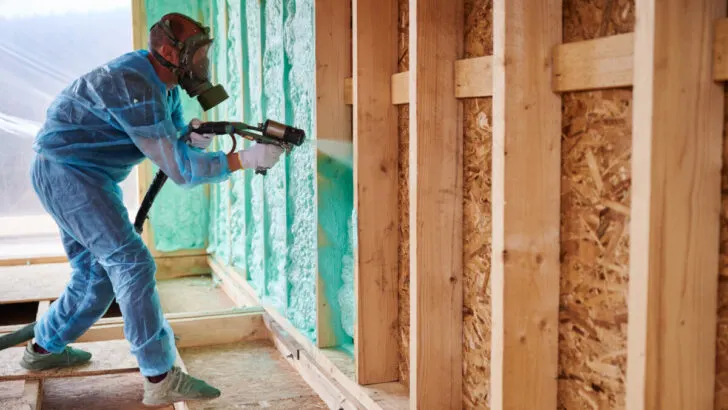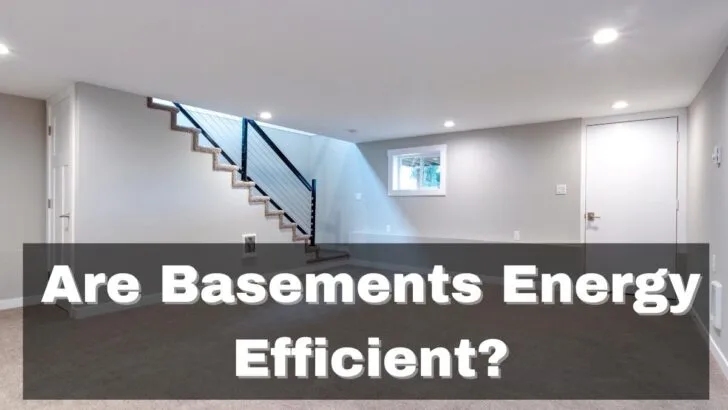While basements are mostly known to be damp and dark places, there are ways one can make them more energy efficient as well.
Generally, basements tend to be more energy efficient due to the surrounding soil. As a result, less insulation may be needed in basement walls to prevent heat loss than is needed on upper floor levels.
However, there is still more to this, so let us have a look at them in detail.
6 Ways To Make Your Basement More Energy Efficient
Basements are commonly the most neglected part of the house when it comes to making the house more modern or efficient.
However, basements are the best in providing opportunities for repairs and improvements that will lower your energy usage. Here are six ways you could make your basement more energy efficient.
Explore New Lighting Options
Naturally, basements have poor lighting. Since their low ceilings and inadequate natural lighting are common, track or halogen pot lighting solutions are a must.
For a cheap upgrade, swap out these light bulbs for long-lasting fluorescent bulbs or LED. On the other hand, you could go for a large renovation if your budget allows it, such as converting egress windows into lookout windows.
More windows will let in natural light, which will reduce the need for electricity and improve the comfort of the area.
Start Using Portable Heaters, Fans, And Dehumidifiers
Adjust the primary thermostat to restrict cooling or heating the entire house when you spend more time in the basement than the rest of the house. Try adjusting the thermostat some degrees higher or lower while using the portable heaters, fans, and dehumidifiers as an alternate.
Your bills should change as a result of these choices as some industry experts claim that changing the thermostat by only one degree may save expenditures by two percent.
To reduce humidity in the basement, you might occasionally need to run a single-room dehumidifier.
When people sleep in the basement but the rest of the home is pleasant, dehumidifiers are extremely helpful.
Swap Out The Old Windows
The windows in parts of your home that are infrequently used are often the least energy-efficient, which may be allowing air to escape from your home.
By swapping them out for more energy-efficient ones, you can keep cooled and heated air inside, as well as strengthen your home’s security by making it more difficult for intruders to break in.
Get New Appliances
By replacing the appliances in your home’s basement bathrooms and laundry rooms, you may increase the energy efficiency of your house.
Purchase a high-efficiency washer and dryer and replace that old toilet with a new low-flow one. Even while the initial cost may be high, you’ll likely start to save money on electricity.
Completely Cover The Crawlspace
If your home was constructed in the 1970s or earlier, the crawl space in your basement may be causing humidity issues.
Because of the venting in the crawlspace, moisture from the outside can enter the home, making your air conditioner work harder to dry out the air inside.
Your cooling costs should be reduced by simply covering the crawl space with plastic sheeting to prevent the entry of moisture.
Insulate The Basement Walls

In case your basement is not completed, the walls may not be sufficiently insulated. This implies that the energy you need to keep your house warm is being lost.
Where you live will determine the appropriate thickness of the insulation in your basement, therefore it’s worthwhile to hire a contractor to assess your present insulation levels.
Adding insulation should be your priority if you intend to complete your basement because the price goes up significantly once the walls are built.
What Is The Most Energy-Efficient Housing?
The best option for a house considering energy efficiency is to go for a dome or igloo-shaped house.
The reason lies behind the fact that a dome shape doesn’t allow outside air to penetrate the house easily while keeping a consistent temperature within the house. The dome allows outside wind to easily move over the house. The other alternative is cube-shaped houses.
Dome
The dome is without a doubt the shape of the house that uses the least energy. This half-sphere has no edges and a large base.
By eliminating the corners of the house, which is where energy loss typically occurs, wind can move freely.
The air pressure stays constant since wind may pass through the house without causing any issues. This affects the rate of air penetration, which is slower in a structure with a dome.
Less air penetration prevents outside air from leaking into the house, which raises summertime temperatures and lowers wintertime ones.
Further domed homes are more environmentally friendly than their angular counterparts. It is possible to improve natural air circulation by adding a cupola with vents to the top of the dome.
For those not familiar with the term, a cupola is a modest addition to the roofs of houses and structures. Interestingly, it has a dome form as well.
Igloo architecture is quite energy-efficient, even though it may appear impossible. The snow and dome design work as an insulator for the inside as well as giving it the exterior dome qualities.
Also in hot regions, domed houses work remarkably well. The majority of dome homes have one storey.
Heat rises, therefore before the interior temperature could start to rise, the warm air would ascend through the cupola’s vents and leave the building.
Cube
A cube is the second-most energy-efficient housing form. It's important to note that we avoided using the word "rectangular" as obviously, cubes and rectangles differ from one another.
Unlike the majority of houses, a cube-shaped house doesn’t have any triangular ceilings and protrusions such as dormers, bay windows, turrets, or bump-outs.
While these added elements increase the aesthetics of a home, these protrusions found throughout the structure dramatically lower the property’s energy efficiency.
Despite being more conventional than a dome, a cube’s design won’t provide problems with heating and cooling.
Each side of the cube is the same length. That enables the house to have good ventilation even though it has sharp corners rather than rounded edges. The greatest solution for sustainability is to keep the house small.
Final Words on Energy Efficient Basements
To summarize, basements naturally tend to be energy efficient, as they are warmer in winter and cooler in summer.
But in the majority of households, basements are the least renovated place of the entire house and when dealing with energy inefficiencies they are the best place to curb energy wastage.
Further, when deciding to build a house with energy efficiency in mind, the best option is to go for a dome shape.


